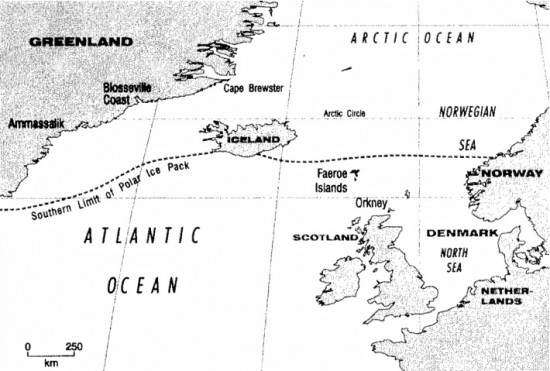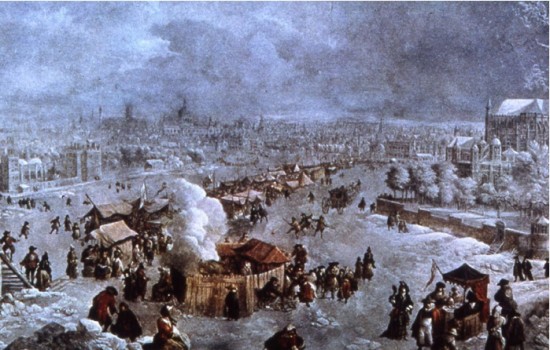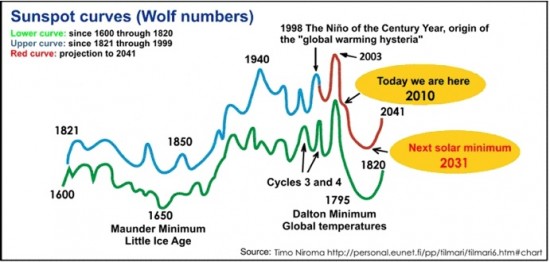Climate History Key to Future; Inuit Travels Provide Political Direction
World governments continue to ignore the climate realities. Pushed by environmentalists with political agendas who know nothing.
Dr. Tim Ball at Canada Free Press
Meanwhile nature ignores the false science. Solar activity declines, global temperatures decline and both will continue to do so.
Temperature conditions similar to those of the Dalton Minimum, and if the quiescence continues, the Maunder Minimum are anticipated (Figure 1).
What does that imply?
Unique, Research
Some fascinating examples of conditions during the Little Ice Age (LIA) are reported in a wonderful book titled, “In Order to Live Untroubled” that evolved from her doctoral thesis, Renee Fossett provides a fascinating history of the contact between Inuit and Europeans in the Central Arctic between 1550 and 1940. Ms. Fossett lived among the Inuit and learned their language prior to working on the doctorate. A fascinating theme of the book is the change in climate, particularly the Little Ice Age (LIA) and its impact. Principle among these is the effect on food supply and the subsequent movement of people to survive.
Historic Ice Conditions
People moved into more northerly regions of North America during the much warmer conditions of the Medieval Warm Period. Vikings sailed in Arctic waters now permanent pack ice and built settlements in Northern Newfoundland and on Ungava Bay. As the sun went into decline, correlated with reduced sunspot numbers of the Maunder Minimum, the world cooled from 1450 AD. Glaciers expanded and sea ice extended over much larger areas. Viking settlements in Greenland were isolated. A 1492 letter of Pope Alexander VI reporting on conditions in Greenland says, “shipping to that country is very infrequent because of the extensive freezing of the waters – no ship having put in to shore, it is believed, for eighty years – or if voyages happened to be made, it could have been, it is thought, only in the month of August…” H.H Lamb lists nine measurable effects including “Increasing spread of the Arctic ice sea ice into all the northernmost Atlantic and around Greenland, forcing the abandonment of the old sailing routes to Greenland which had been used from about A.D 1000 to 1300.”
Ice blocked shipping it provided a bridge between islands. It was the ice bridge across the Bering Straits that provided the route from Asia to North America that made Inuit the last arrivals on the continent. Stories of this travel are still part of the oral tradition. Fossett writes about increased frequency of Inuit crossing as the ice expanded to the east. Travel to hunting areas and moving with migrating animals like caribou is basic to the Inuit way of life. Figure 2 shows the extent of the pack ice and the connection between Greenland and Iceland. This southern extent is confirmed by a change in the sailing orders issued by the Hudson’s Bay Company. As the Earth warmed out of the LIA and the pack ice retreated the orders allowed them to sail further north.

Figure 2: North Atlantic showing mean LIA Ice Pack location. Source: Fossett, 2001, In Order To Live Untroubled. U of Manitoba Press.
Figure 2: North Atlantic showing mean LIA Ice Pack location.
Source: Fossett, 2001, In Order To Live Untroubled. U of Manitoba Press.
Notice the ice extending north of the Faeroes to Norway. These limits are based on reports but represent an average. We have another indicator of how far south the ice came because in a letter to the Admiralty in 1817 the Royal Society wrote, “The ice this year that has surrounded the northern coast of Ireland in unusual quantity and remained unthawed till the middle of August.” The comment “unusual quantity” implies it was regular to have ice each year. It was unusual because of cooling following the eruption of Tambora in 1815.
Remarkable Stories
The nadir of the LIA was in the 1680s with a meter of ice on the Thames as Grifier’s 1683 painting, “The Great Frost” illustrates. It is not surprising that Fossett reports between 1682 and 1701, “several local historians in the Orkneys and northern Scotland commented on the appearance of mysterious strangers in skin boats along the coasts.” Consider these reports from reliable observers.

Jan Grifier, London 1683 The Great Frost
Reverend James Wallace of Kirkwall, Orkney wrote, “Sometimes about this Country are seen these Men which are called Finn-men. In the year 1682 one was seen sometimes sailing, sometimes Rowing up and down in his little Boat at the south end of the Isle of Eda, most of the people of the Ile flock’d to see him, and when they adventur’d to put a Boat with Men to see if they could apprehend him, he presently fled away most swiftly.”
Reverend John Brand reported frequent appearances of strangers in skin boats off the coasts of the Isles of Orkney, near Stronsay in 1699 and Westray 1700. The description leaves little doubt. “His boat is made up of Seal skins, or some kind of leather, he also hath a Coat of Leather upon him, and he sitteth in the middle of his Boat, with a little Oar in his hand, Fishing with his Lines” More detail that clarifies the identity was given by Reverend Wallace’s son Dr Jame Wallace. Be the Seas never so boisterous their Boat being made of Fish Skins, are so contrived that he can never sink, but is like a Sea-gull swimming on the top of the Water. His shirt he has is so fastened to the Boat, that no Water can come into his Boat to do him damage, except when he pleases to unty it which he never does but to ease nature, or when he comes ashore.”
Most remarkable is the report by the Reverend Francis Gatrell of a kayak he saw in an Aberdeen museum in 1760. The kayak was, “driven into the Don with a man in it who was all hairy, and spoke a language which no person there could interpret. He lived but three days.” Fossett notes, “An increasing body of convincing evidence that the kayaks and their inhabitants were North American was produced during the twentieth century.” The Don enters the North Sea at Aberdeen on the east coast of Scotland. There’s little doubt who these people were considering the climate and resulting ice conditions.
Wrong Direction
Meanwhile world governments continue to ignore the climate realities. Pushed by environmentalists with political agendas who know nothing, they are preparing us for completely the wrong future. What impact will such ice conditions have on shipping and thereby world trade today? What about increased demand for energy to offset the cold? What about agricultural production? All the people who are putting us in this mess will be long gone living on their ill-gotten gains including big fat pensions.
Dr. Tim Ball, is a member of CFP’s Speakers’ Bureau.
Dr. Tim Ball Bio
Help Make A Difference By Sharing These Articles On Facebook, Twitter And Elsewhere:

